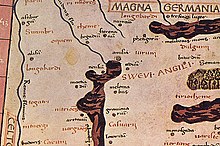Gauonarion
Gauonarion (also Gravionarion ; Greek Γαυονάριον or Γραυιονάριον; Latin: Gauonarium or Gravionarium ) is a place name that appears in the Geographia of Claudius Ptolemaios (2, 11, 14) as one of the places in the interior of Germania with 30 ° ° 00 (πόλεις) ' Longitude ( Ptolemaic longitudes ) and 50 ° 00' latitude are given. According to Ptolemy, Gauonarion is close to the ancient places Melokabos and Lokoriton in Germania magna. Due to the age of the spring, the age of the settlement can be assumed to be around ± 150 AD.
localization
So far the ancient place could not be located with certainty. From 2006 to 2009, a research group at the Technical University of Berlin, headed by Dieter Lelgemann , undertook the scientific attempt to transform the ancient coordinates for 94 ancient locations in the Germania magna (Germania beyond the Limes) into the coordinate system that is valid today. This research team is currently locating Gauonarion in the area near Schlüchtern an der Kinzig in Hesse . The result confirms the “equation” of Schlüchtern with Gauonarion by Theodor Steche in 1937. An inaccuracy of the transformed coordinates of up to 15 kilometers must be taken into account. Since the transformed coordinates have their center at Neuhof - Hattenhof , Schlüchtern is only on the edge of the 15 kilometer circle.
etymology
Both Gavi - and Gravi - can be derived from the Celtic rather than the Germanic. The typeface αυ can stand for au , aw or ab .
Remarks
- ↑ Book II, Chapter 10: Greater Germany (Fourth Map of Europe) ( English ) penelope.uchicago.edu. Retrieved April 16, 2019.
- ↑ a b cf. Hermann Reichert : Gauonarion. In: Reallexikon der Germanischen Altertumskunde (RGA). 2nd Edition. Volume 10, Walter de Gruyter, Berlin / New York 1998, ISBN 3-11-015102-2 , pp. 483-484. ( chargeable via GAO , De Gruyter Online)
- ↑ See Andreas Kleineberg, Christian Marx, Eberhard Knobloch, Dieter Lelgemann : Germania and the island of Thule. The decoding of Ptolemy's "Atlas of the Oikumene". Scientific Book Society, Darmstadt 2011, ISBN 978-3-534-24525-3 , p. 53.
- ^ Theodor Steche : Old Germania in the geography book of Claudius Ptolemäus , 1937, p. 161.
literature
- Hermann Reichert : Gauonarion. In: Reallexikon der Germanischen Altertumskunde (RGA). 2nd Edition. Volume 10, Walter de Gruyter, Berlin / New York 1998, ISBN 3-11-015102-2 , pp. 483-484. ( chargeable via GAO , De Gruyter Online)
- Hermann Reichert : Ptolemaeus. In: Reallexikon der Germanischen Altertumskunde (RGA). 2nd Edition. Volume 23, Walter de Gruyter, Berlin / New York 2003, ISBN 3-11-017535-5 , pp. 567-597. ( chargeable via GAO , De Gruyter Online)
- Alfred Stückelberger, Gerd Graßhoff (ed.): Ptolemaios, Handbook of Geography (Greek-German) . Schwabe Verlag, Basel 2006, ISBN 3-7965-2148-7 (work in 2 half-volumes, with CD-ROM).
- Corinna Scheungraber, Friedrich E. Grünzweig: The old Germanic toponyms as well as non-Germanic toponyms of Germania. A handbook on its etymology using a bibliography by Robert Nedoma. Published by Hermann Reichert (= Philologica Germanica 34). Fassbaender, Vienna 2014, ISBN 978-3-902575-62-3 , pp. 172-174.
Web links
- Edition of Geographike Hyphegesis with translation and map of Germania magna , accessed on June 17, 2015
- Google Earth in ancient times. In: Der Spiegel. 39/2010, accessed June 17, 2015
